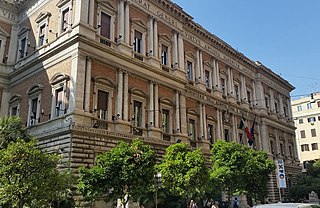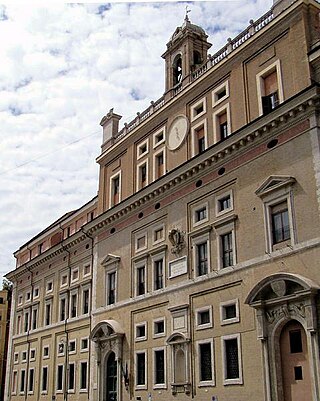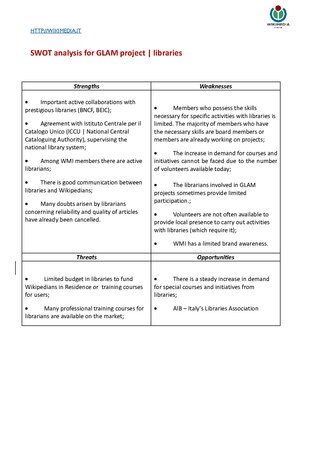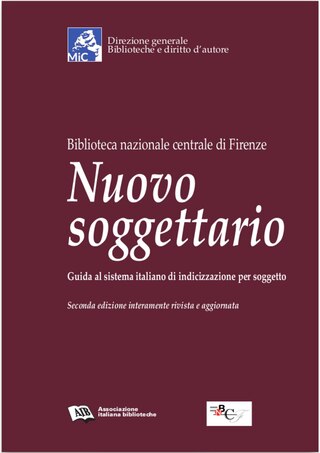The National Library Service of Italy (Italian : Servizio bibliotecario nazionale, SBN) is a Ministry of Cultural Heritage and Activities promoted network of Italian libraries, in collaboration with Regions and Universities, and coordinated by the Central Institute for the Union Catalogue of Italian Libraries and Bibliographic Information (Italian : Istituto centrale per il catalogo unico delle biblioteche italiane e per le informazioni bibliografiche, ICCU).
The project for the National Library System is born with the goal of overcoming the fragmentation of, and fostering the co-operation among, Italian library structures, on the impulse of the National Conference of Italian Libraries held in Rome from 22 to 24 January 1979. It was designed by Angela Vinay (Director of ICCU) and Michel Boisset (Director of the European University Institute Library), [1] in collaboration with a group of librarians and computer scientists. The planning phase was officially started on 4 April 1980, with the establishment of an experts' commission made up of representatives from the Ministry of Cultural Heritage and Activities (MCHA), the ICCU, the National Central Library of Florence, the European University Institute and the National Research Council.
The final document produced by the Commission proposed the creation of the service, articulated in:
In 1982 the project was presented by Angela Vinay to the library community on the occasion of the 30th Congress of the Italian Libraries Association held in Giardini-Naxos on 21–24 November 1982. [3] In 1984, MCHA subscribed a protocol of understanding with Regions for the development of the SBN project. [4]
In 1985, the first two Poles were established, those of the National Central Libraries of Rome and Florence. From 1987 to 1990, the project "Library Heritage System" (Italian : Sistema beni librari) made it possible to recover the catalogues of the National Italian Bibliography (Bibliografia nazionale italiana, BNI), the Bulletin of Foreign Modern Works (Bollettino delle opere moderne straniere, BOMS) and other catalogues related to music and Southern Italy-theme funds, which came to constitute the first substantial nucleus of the catalogue. In 1992, the protocol of understanding MCHA-Regions was extended to the Ministry of University and Scientific and Technological Research involving many university libraries in the project. [5] In addition, through the connection of more Poles to the SBN network, the national network was officially activated.
In 1996 a feasibility study was started to create a single database, integrating the previous ones related to modern books, ancient books and music, [6] and enable the management of graphic and cartographic material, also allowing a certain degree of interoperability with programs not developed within SBN. [7]
In 2002, with the startup of the project "Evolution of the SBN Index" (Evoluzione dell'Indice SBN), a restructuring and a rationalization of the Index central database, as well as its opening to other library management systems not related to SBN, using the more widespread bibliographic formats (UNIMARC, MARC21). [8]
The National Library Service connects state, local authorities, university and private libraries operating in different disciplinary sectors. Participating libraries are grouped in local hubs, connected in turn to the SBN Index, which contains the collective catalogue of the heritage possessed by the libraries adhering to the service. Adherence to the service implies for the library or local library hub to subscribe an agreement with ICCU, to define their respective commitments to the development of SBN and related services. [9]
One of the fundamental functions of the National Library Service is the participatory cataloguing among adhering libraries: every bibliographic record (books, authority codes or other things) is described only once by the library or library hub which acquires it first. The other libraries merely report the record already registered within the Index in their own catalogue, only adding the indication that they also possess that given record.
However, the single hub databases only share the bibliographic description of the record, thus keeping total autonomy regarding the possibility of adding further information (such as the local position of a book, purchasing orders, more specific search keys, etc.). Libraries also have full autonomy as to organizational choices and hardware and software investments.
As of 5 November 2018 6,320 libraries (organised in 104 hubs) [10] adhere to it, and the bibliographic database contains 17,162,840 bibliographic records, complete with 92,110,636 locations (that is, indications about the library possessing them). [11] The collective catalogue includes documents of different types: ancient material (printed monographies from the 15th century to 1830), modern material (monographies, audio and video recordings, electronic databases, periodicals and other materials since 1831), handwritten music, printed music and libretti, graphic and cartographic material. [12] Accesses to the catalogue pages range between 2.8 millions and 4.6 millions per month. [13]
There are two large papal libraries, the Vatican Library in Vatican City and the Ambrosian Library in Milan.
Since 1997, the collective catalogue is available on line by means of the OPAC system, which over time saw the creation of various interfaces. [14] Completing the search a set of services are available, such as for example the save of the searches made during the session, the management of favourites lists and the sending of results via e-mail.
Through the OPAC consultation is also possible:
The National Library Service puts at disposal the Inter library loan SBN (ILL SBN), a national service of interlibrary loan and document delivery, accessible to everybody and addressed to librarians and end users. [15]
The interlibrary loan service was at the base of the SBN project, having integrated competences and projects which had been started in November 1979 by the working group "Co-operation Experience" (Esperienza di cooperazione, ECO), later continued in the project "National Document Access Service" (Servizio nazionale di accesso ai documenti, SNADOC), started in Tuscany in the mid-1980s. [16]
In the 2010s, the loan service can be accessed through the catalogue of the National Library Service, via the ACNP national serial catalogue (Catalogo italiano dei periodici, "Italian Union Catalogue of Serials") and the ESSPER serial catalogue (Catalogo collettivo di spogli di periodici italiani di economia, scienze sociali e storia dell'Associazione ESSPER, "Collective Catalogue of Selected Italian Periodicals of Economics, Social Sciences and History of the ESSPER Association"). [17]

The Ministry of Agriculture, Food Sovereignty and Forests, Italian: Ministero dell'agricoltura, della sovranità alimentare e delle foreste or MASAF, is an Italian government department.

The Biblioteca Nazionale Vittorio Emanuele III is a national library of Italy. It occupies the eastern wing of the 18th-century Palazzo Reale in Naples, at 1 Piazza del Plebiscito, and has entrances from piazza Trieste e Trento. It is funded and organised by the Direzione Generale per i Beni Librari and the Ministero per i Beni e le Attività Culturali.

The Ministry of Culture is the ministry of the Government of Italy in charge of national museums and the monuments historiques. MiC's headquarters are located in the historic Collegio Romano Palace and the current Minister of Culture is Alessandro Giuli.

The Central Institute for the Union Catalogue of Italian Libraries and for Bibliographic Information is an Italian government agency that was created in 1975 to supersede the Centro nazionale per il catalogo unico, that had in turn been created in 1951 to build a single catalog of all the libraries in the nation.
Francesco Racanelli (1904–1978) was an Italian doctor, pranotherapist and writer, and the originator of an unconventional therapy that he called in Italian: medicina bioradiante or "bio-radiant medicine".
AthenaPlus is a CIP best practice network started in March 2013 which aims to facilitate access to networks of cultural heritage, enrich metadata, as well as improve search, retrieval and re-use of Europeana's content by enhancing multilingual terminology management and the export/publication tool. By the end of the project, AthenaPlus will contribute more than 3.6 millions of metadata records to Europeana, from both public and private sectors, focusing mainly on museums content. In addition to enabling access to cultural heritage, AthenaPlus is also focused on creative use of content, and adapting data to users with different needs by means of tools that support the development of virtual exhibitions, tourist and didactic applications.

Carlo Curti was a Bolognese Italian cellist, educator and composer. He studied violin under Rolla, and then the cello under Parisini. He was made professor at the Liceo di Musica as a young man and in May 1838 became First Cello in the Teatro Regio in Parma when it was led by Nicola De Giovanni. He retired to Bologna, his home town and birthplace, in 1871 or 1872 and died from a cardiac condition caused by pneumonia soon after. The 17 May 1838 issue of the music journal Teatri Art E Letteratura pointed to him as him an example of Italian musical excellence, a gift to the world.
Vittorio Emanuele Vincenzo Giuseppe Calestani was an Italian botanist at the University of Modena, whose work included a classification system for angiosperms.

The Italian photographer Gianni Berengo Gardin has been the sole contributor or a major contributor to a large number of photobooks from 1960 to the present.
The following is a timeline of the history of the city of Syracuse, Sicily, Italy. Syracuse was the main city of Sicily from 5th century BCE to 878 CE.
The following is a timeline of the history of the city of Parma in the Emilia-Romagna region of Italy.

The Nuovo soggettario is a subject indexing system managed and implemented by the National Central Library of Florence, that in Italy has the institutional task to curate and develop the subject indexing tools, as national book archive and as bibliographic production agency of the Italian National Bibliography. It can be used in libraries, archives, media libraries, documentation centers and other institutes of the cultural heritage to index resources of various nature on various supports
Trieste Contemporanea is a cultural centre based in Trieste (Italy). Founded as a committee in 1995, it carries out a prevalent research activity into the field of Central Eastern European contemporary visual arts. The Centre dedicates to the artistic and curatorial practices of this European area exhibitions, events, conferences and workshops, editorial productions, international special projects and some recurring initiatives including the CEI Venice Forum for Contemporary Art Curators, the Trieste Contemporanea International Design Competition, the Young European Artist Trieste Contemporanea Award.
Biblioteca e Archivio del Risorgimento [Library and Archive of the Risorgimento], located in the Historic Center of Florence, houses regional collections relating to the Italian unification and the mid-18th century.

Nino Camardo is an Italian naïve art painter.

Antonio Veretti was an Italian composer.

Holy Family with the Infant Saint John the Baptist and Saint Mary Magdalene is a 1508–1512 oil-on-panel painting by the Venetian painter Palma Vecchio. It was in archduke Leopold William of Austria's collection in Brussels from 1653 to 1662 before being moved to the Imperial Galleries in Vienna, before finally being exchanged for another work with the Uffizi in Florence in 1793, where it is now inventory number 950.
Enrico Narducci was an Italian librarian, bibliographer and paleographer.

Domenico Bellando (1868-1922) was an Italian organist, teacher and composer, best known as a composer of music for church services, piano pieces and songs.
Eugenio Riccomini was an Italian art historian. He died on 25 December 2023, at age of 87.